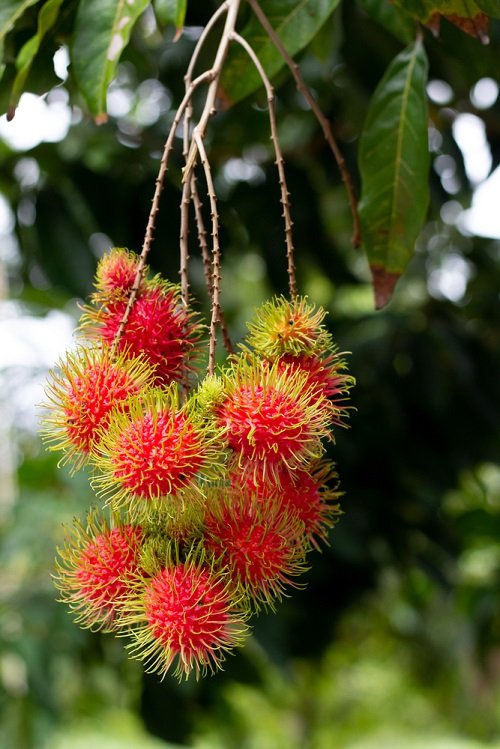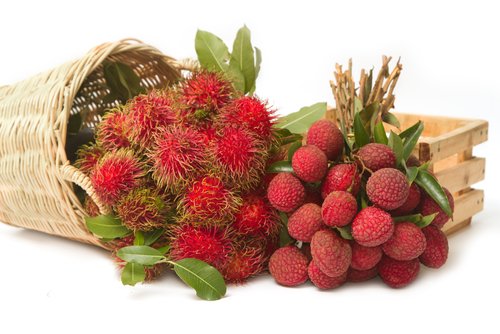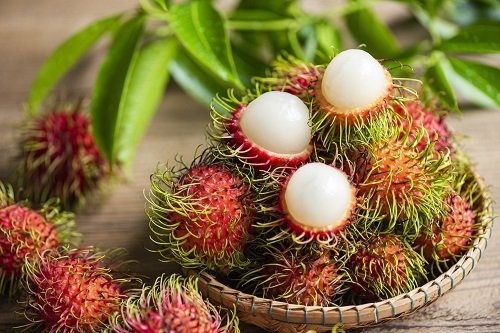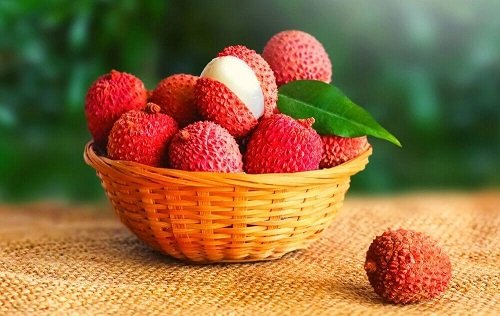Lychee vs. Rambutan—A sweet battle of exotic fruits! Learn about their unique tastes, textures, and appearances in this comparison guide.
These two tropical delights have a lot in common! Don’t let their sweet juicy taste and almost similar appearance trick you; learn the differences in this extensive Lychee vs. Rambutan guide below.
Find the Differences between Coconut and Palm Trees here
What is Lychee?

Native to Southern China, Lychee (Litchi chinensis) is a delectable fruit from the soapberry family (Sapindaceae).
The 40 feet tall evergreen tree with a round, dense canopy of shiny leaves and a thick, gnarled trunk produces clusters of small, fragrant flowers that bloom in the spring, followed by the fruit in the summer, which is a small, round berry, about 2-3 cm in diameter, with a tough, inedible red or pink skin.
The flesh of the fruit is translucent, juicy, and sweet, with a flavor that is often described as a combination of sweet and floral.
What Does Lychee Taste Like? Find here
What is Rambutan?

Rambutan (Nephelium lappaceum) is a tropical fruit species from the soapberry family (Sapindaceae). It originates from Southeast Asia and is found in Thailand, Indonesia, and the Philippines.
This fruit is known for its unique appearance, with a red, hairy exterior that resembles a sea creature, giving it the name. It grows in large clusters and is about the size of a golf ball, with an average size of about 2-3 cm in diameter.
The juicy white flesh is surrounded by a translucent, inedible layer with an inedible, hard seed at the center. Rambutan is enjoyed fresh or can be found canned, dried, or made into juice or other sweet treats.
Learn about Growing Strawberry Tomatoes here
Similarities Between Lychee and Rambutan?
Family: Lychee and rambutan belong to the soapberry family (Sapindaceae) in addition to the horse chestnut, maples, ackee, and longan fruit.
Consumption: Rambutan and Lychee can be enjoyed similarly by peeling away the outer skin as a snack or in fruit salads.
Culinary Use: Both fruits are enjoyed fresh and can be used in desserts, juices, and other culinary applications.
Nutritional Content: Lychee and rambutan share similar health benefits, such as high antioxidants, vitamin C, fiber, hydration, and low-calorie content.
Health Benefits: These soapberry family members are rich in nutrients & offer various health benefits. They are high in antioxidants, boost immunity, support heart health, promote digestion, and are also good for skin health.
Get the Best Rhododendron vs. Magnolia Guide here
Differences Between Lychee and Rambutan?
Origin: Lychee was first grown in the southern province of Fujian and Guangdong in China. Though first records of fruit date back to the Tang Dynasty. Whereas, Rambutan is native to Southeast Asia, specifically the Malay Peninsula.
Appearance: The most noticeable difference between lychee and rambutan is their appearance. Lychee has a rough, red exterior with small protuberances, while rambutan has a spiky, hairy exterior that is usually red or green.
Taste: Lychee has a sweeter, crisper flesh and a floral aroma similar to mangosteen or watermelon. In contrast, rambutan has a slightly creamy flavor with a more neutral aroma, like dragon fruit.
Fruit Texture: The flesh texture inside the fruit is pretty distinct. Lychee has firmer flesh, while rambutan has a softer, more jelly-like texture.
Size: Both Lychee and Rambutan are small to medium-sized fruits, typically measuring around 2-3 cm in diameter. Lychee tends to be slightly smaller than its competitor, while rambutan can sometimes be slightly larger, depending on the variety and growing conditions.
Look at the Best Green Fruits here
How to Eat —Lychee vs. Rambutan
Lychee and Rambutan are both easy to eat and can be enjoyed in several different ways. Here are some common methods for eating these tropical fruits:
Raw: Lychee and rambutan can be eaten fresh, straight from the tree. To eat, peel off the outer layer and remove the seed. The fruit’s flesh can then be eaten as it is or chopped into your salad platter.
Canned: Both fruits can be canned in syrup, consumed as a sweet snack, or squeezed in recipes.
Juices and Smoothies: The sweet and juicy flesh of lychee and rambutan can be blended into juices or smoothies for a refreshing drink.
Cocktails: The sweet and fruity flavor of both lychee and rambutan make them popular ingredients in cocktails, such as martinis and margaritas.
Desserts: Both the drupes are used in desserts, such as fruit salads, ice creams, and cakes.
Learn about the Best Palm Fruits here
Conclusion
Albeit lychee and rambutan may look similar, they are prominently distinct in appearance, taste, texture, seed, and origin. Both fruits offer unique flavor and texture profiles, making them popular choices for fruit lovers.





